First Evidence of Contourite Drifts in the North-Western Sicilian Active Continental Margin (Southern Tyrrhenian Sea)
Abstract
1. Introduction
2. Regional Setting
2.1. Geological Setting
2.2. Oceanographic Setting
3. Data and Methods
4. Results
4.1. Seismic Stratigraphy and Identification of Elongated Deposits
4.2. Geomorphological Expression and Characters of Elongated Deposits
5. Discussion
5.1. Interpretation of Seismic Facies
5.2. Contourite Drifts in the North-Western Sicilian Margin
5.3. Controlling Factors in Contourite Drift Deposition in the North-Western Sicilian Continental Margin
6. Conclusions
Supplementary Materials
Author Contributions
Funding
Institutional Review Board Statement
Informed Consent Statement
Data Availability Statement
Acknowledgments
Conflicts of Interest
References
- Rebesco, M.; Hernández-Molina, F.J.; Van Rooij, D.; Wåhlin, A. Contourites and associated sediments controlled by deep-water circulation processes: State-of-the-art and future considerations. Mar. Geol. 2014, 352, 111–154. [Google Scholar] [CrossRef]
- Hernández-Molina, F.J.; Wåhlin, A.; Bruno, M.; Ercilla, G.; Llave, E.; Serra, N.; Rosón, G.; Puig, P.; Rebesco, M.; Van Rooij, D. Oceanographic processes and morphosedimentary products along the Iberian margins: A new multidisciplinary approach. Mar. Geol. 2016, 378, 127–156. [Google Scholar] [CrossRef]
- Rebesco, M.; Camerlenghi, A. Contourites; Elsevier: Amsterdam, The Netherlands, 2008; ISBN 9780444529985. [Google Scholar]
- Rebesco, M.; Özmaral, A.; Urgeles, R.; Accettella, D.; Lucchi, R.G.; Rüther, D.; Winsborrow, M.; Llopart, J.; Caburlotto, A.; Lantzsch, H. Evolution of a high-latitude sediment drift inside a glacially-carved trough based on high-resolution seismic stratigraphy (Kveithola, NW Barents Sea). Quat. Sci. Rev. 2016, 147, 178–193. [Google Scholar] [CrossRef]
- Hanebuth, T.J.J.; Zhang, W.; Hofmann, A.L.; Löwemark, L.A.; Schwenk, T. Oceanic density fronts steering bottom-current induced sedimentation deduced from a 50 ka contourite-drift record and numerical modeling (off NW Spain). Quat. Sci. Rev. 2015, 112, 207–225. [Google Scholar] [CrossRef]
- Miramontes, E.; Garreau, P.; Caillaud, M.; Jouet, G.; Pellen, R.; Hernández-Molina, F.J.; Clare, M.A.; Cattaneo, A. Contourite distribution and bottom currents in the NW Mediterranean Sea: Coupling seafloor geomorphology and hydrodynamic modelling. Geomorphology 2019, 333, 43–60. [Google Scholar] [CrossRef]
- Ercilla, G.; Juan, C.; Hernandez-Molina, F.J.; Bruno, M.; Estrada, F.; Alonso, B.; Casas, D.; lí Farran, M.; Llave, E.; Garcia, M. Significance of bottom currents in deep-sea morphodynamics: An example from the Alboran Sea. Mar. Geol. 2016, 378, 157–170. [Google Scholar] [CrossRef]
- Faugères, J.C.; Stow, D.A.V.; Imbert, P.; Viana, A. Seismic features diagnostic of contourite drifts. Mar. Geol. 1999, 162, 1–38. [Google Scholar] [CrossRef]
- Rebesco, M.; Wåhlin, A.; Laberg, J.S.; Schauer, U.; Beszczynska-Möller, A.; Lucchi, R.G.; Noormets, R.; Accettella, D.; Zarayskaya, Y.; Diviacco, P. Quaternary contourite drifts of the Western Spitsbergen margin. Deep Res. Part I Oceanogr. Res. Pap. 2013, 79, 156–168. [Google Scholar] [CrossRef]
- Esentia, I.; Stow, D.; Smillie, Z. Contourite drifts and associated bedforms. In Submarine Geomorphology; Springer: Cham, Switzerland, 2018; pp. 301–331. [Google Scholar]
- Heezen, B.C.; Hollister, C.D.; Ruddiman, W.F. Shaping of the continental rise by deep geostrophic contour currents. Science 1966, 152, 502–508. [Google Scholar] [CrossRef]
- Nutz, A.; Lajeunesse, P.; Ghienne, J.-F.; Schuster, M.; Brouard, E.; Dietrich, P.; Bouchette, F.; Roquin, C.; Cousineau, P.A. Deglacial to paraglacial history of the Lake Saint-Jean Lowlands: A geomorphological perspective. In Landscapes and Landforms of Eastern Canada. World Geomorphological Landscapes; Slaymaker, S.O., Catto, N., Eds.; Springer: Cham, Switzerland, 2020; ISBN 978-3-030-35137-3. [Google Scholar]
- Juan, C.; Ercilla, G.; Estrada, F.; Alonso, B.; Casas, D.; Vázquez, J.T.; d’Acremont, E.; Medialdea, T.; Hernández-Molina, F.J.; Gorini, C. Multiple factors controlling the deep marine sedimentation of the Alboran Sea (SW Mediterranean) after the Zanclean Atlantic Mega-flood. Mar. Geol. 2020, 423, 106138. [Google Scholar] [CrossRef]
- Viana, A.R. Economic relevance of contourites. Dev. Sedimentol. 2008, 60, 491–510. [Google Scholar]
- Yu, X.; Stow, D.; Smillie, Z.; Esentia, I.; Brackenridge, R.; Xie, X.; Bankole, S.; Ducassou, E.; Llave, E. Contourite porosity, grain size and reservoir characteristics. Mar. Pet. Geol. 2020, 117, 104392. [Google Scholar] [CrossRef]
- Laberg, J.S.; Camerlenghi, A.; Rebesco, M. Chapter 25 The Significance of Contourites for Submarine Slope Stability; Rebesco, M., Camerlenghi, A., Eds.; Elsevier: Amsterdam, The Netherlands, 2008; ISBN 9780444529985. [Google Scholar]
- Cattaneo, A.; Miramontes, E.; Samalens, K.; Garreau, P.; Caillaud, M.; Marsset, B.; Corradi, N.; Migeon, S. Contourite identification along Italian margins: The case of the Portofino drift (Ligurian Sea). Mar. Pet. Geol. 2017, 87, 137–147. [Google Scholar] [CrossRef]
- Solheim, A.; Berg, K.; Forsberg, C.F.; Bryn, P. The Storegga Slide complex: Repetitive large scale sliding with similar cause and development. Mar. Pet. Geol. 2005, 22, 97–107. [Google Scholar] [CrossRef]
- Kane, I.A.; Clare, M.A.; Miramontes, E.; Wogelius, R.; Rothwell, J.J.; Garreau, P.; Pohl, F. Seafloor microplastic hotspots controlled by deep-sea circulation. Science 2020, 368, 1140–1145. [Google Scholar] [CrossRef] [PubMed]
- Stow, D.A.V.; Faugères, J.C.; Howe, J.A.; Pudsey, C.J.; Viana, A.R. Bottom currents, contourites and deep-sea sediment drifts: Current state-of-the-art. Geol. Soc. Mem. 2002, 22, 7–20. [Google Scholar] [CrossRef]
- Juan, C.; Ercilla, G.; Hernández-Molina, F.J.; Estrada, F.; Alonso, B.; Casas, D.; García, M.; Llave, E.; Palomino, D.; Vázquez, J.-T. Seismic evidence of current-controlled sedimentation in the Alboran Sea during the Pliocene and Quaternary: Palaeoceanographic implications. Mar. Geol. 2016, 378, 292–311. [Google Scholar] [CrossRef]
- Martorelli, E.; Petroni, G.; Chiocci, F.L.; Bosman, A.; Calarco, M.; Conte, A.M.; Macelloni, L.; Salusti, E.; Sposato, A. Contourites offshore Pantelleria Island (Sicily Channel, Mediterranean Sea): Depositional, erosional and biogenic elements. Geo-Mar. Lett. 2011, 31, 481–493. [Google Scholar] [CrossRef]
- Verdicchio, G.; Trincardi, F. Mediterranean shelf-edge muddy contourites: Examples from the Gela and South Adriatic basins. Geo-Mar. Lett. 2008, 28, 137–151. [Google Scholar] [CrossRef]
- Martorelli, E.; Falcini, F.; Salusti, E.; Chiocci, F.L. Analysis and modeling of contourite drifts and contour currents off promontories in the Italian Seas (Mediterranean Sea). Mar. Geol. 2010, 278, 19–30. [Google Scholar] [CrossRef]
- Ferraro, S.; Sulli, A.; Di Stefano, E.; Giaramita, L.; Incarbona, A.; Graham Mortyn, P.; Sprovieri, M.; Sprovieri, R.; Tonielli, R.; Vallefuoco, M.; et al. Late Quaternary palaeoenvironmental reconstruction of sediment drift accumulation in the Malta Graben (central Mediterranean Sea). Geo-Mar. Lett. 2018, 38, 241–258. [Google Scholar] [CrossRef]
- Spatola, D.; Micallef, A.; Sulli, A.; Basilone, L.; Ferreri, R.; Basilone, G.; Bonanno, A.; Pulizzi, M.; Mangano, S. The Graham Bank (Sicily Channel, central Mediterranean Sea): Seafloor signatures of volcanic and tectonic controls. Geomorphology 2018, 318, 375–389. [Google Scholar] [CrossRef]
- Micallef, A.; Foglini, F.; Le Bas, T.; Angeletti, L.; Maselli, V.; Pasuto, A.; Taviani, M. The submerged paleolandscape of the maltese Islands: Morphology, evolution and relation to quaternary environmental change. Mar. Geol. 2013, 335, 129–147. [Google Scholar] [CrossRef]
- Micallef, A.; Camerlenghi, A.; Georgiopoulou, A.; Garcia-Castellanos, D.; Gutscher, M.-A.; Lo Iacono, C.; Huvenne, V.A.I.; Mountjoy, J.J.; Paull, C.K.; Le Bas, T.; et al. Geomorphic evolution of the Malta Escarpment and implications for the Messinian evaporative drawdown in the eastern Mediterranean Sea. Geomorphology 2019, 327, 264–283. [Google Scholar] [CrossRef]
- Amelio, M.; Martorelli, E. Seismo-stratigraphic characters of paleocontourites along the Calabro-Tyrrhenian margin (Southern Tyrrhenian Sea). Mar. Geol. 2008, 252, 141–149. [Google Scholar] [CrossRef]
- Marani, M.; Argnani, A.; Roveri, M.; Trincardi, F. Sediment drifts and erosional surfaces in the central Mediterranean: Seismic evidence of bottom-current activity. Sediment. Geol. 1993, 82, 207–220. [Google Scholar] [CrossRef]
- Martorelli, E.; Italiano, F.; Ingrassia, M.; Macelloni, L.; Bosman, A.; Conte, A.M.; Beaubien, S.E.; Graziani, S.; Sposato, A.; Chiocci, F.L. Evidence of a shallow water submarine hydrothermal field off Zannone Island from morphological and geochemical characterization: Implications for Tyrrhenian Sea Quaternary volcanism. J. Geophys. Res. Solid Earth 2016, 121, 8396–8414. [Google Scholar] [CrossRef]
- Miramontes, E.; Cattaneo, A.; Jouet, G.; Thereau, E.; Thomas, Y.; Rovere, M.; Cauquil, E.; Trincardi, F. The Pianosa contourite depositional system (northern Tyrrhenian Sea): Drift morphology and Plio-Quaternary stratigraphic evolution. Mar. Geol. 2016, 378, 20–42. [Google Scholar] [CrossRef]
- Lo Iacono, C.; Sulli, A.; Agate, M. Submarine canyons of North-western Sicily (Southern Tyrrhenian Sea): Variability in morphology, sedimentary processes and evolution on a tectonically active margin. Deep Res. Part II Top. Stud. Oceanogr. 2014, 104, 93–105. [Google Scholar] [CrossRef]
- Iacono, C.L.; Sulli, A.; Agate, M.; Lo Presti, V.; Pepe, F.; Catalano, R. Submarine canyon morphologies in the Gulf of Palermo (Southern Tyrrhenian Sea) and possible implications for geo-hazard. Mar. Geophys. Res. 2011, 32, 127–138. [Google Scholar] [CrossRef]
- Sulli, A.; Agate, M.; Iacono, C.L.; Presti, V.L.; Pennino, V.; Polizzi, S. Submarine slope failures along the northern sicilian continental margin (Southern Tyrrhenian Sea) and possible implications for geo-hazard. In Proceedings of the Landslide Science and Practice; Spinger: Berlin/Heidelberg, Germany, 2013; pp. 41–48. [Google Scholar]
- Spatola, D.; Micallef, A.; Sulli, A.; Basilone, L.; Basilone, G. Evidence of active fluid seepage (AFS) in the southern region of the central Mediterranean Sea. Measurement 2018, 128, 247–253. [Google Scholar] [CrossRef]
- Pepe, F.; Sulli, A.; Bertotti, G.; Catalano, R. Structural highs formation and their relationship to sedimentary basins in the north Sicily continental margin (southern Tyrrhenian Sea): Implication for the Drepano Thrust Front. Tectonophysics 2005, 409, 1–18. [Google Scholar] [CrossRef]
- Sulli, A.; Zizzo, E.; Albano, L. Comparing methods for computation of run-up heights of landslide-generated tsunami in the Northern Sicily continental margin. Geo-Mar. Lett. 2018, 38, 439–455. [Google Scholar] [CrossRef]
- Kastens, K.; Mascle, J.; Auroux, C.; Bonatti, E.; Broglia, C.; Channell, J.; Curzi, P.; Emeis, K.C.; Glačon, G.; Hasegawa, S.; et al. ODP Leg 107 in the Tyrrhenian Sea: Insights into passive margin and back-arc basin evolution. Bull. Geol. Soc. Am. 1988, 100, 1140–1156. [Google Scholar] [CrossRef]
- Bonardi, G.; De Capoa, P.; Staso, A.D.; Estévez, A.; Martín-Martín, M.; Martín-Rojas, I.; Perrone, V.; Tent-Manclús, J.E. Oligocene-to-early miocene depositional and structural evolution of the Calabria-Peloritani Arc southern terrane (Italy) and geodynamic correlations with the Spain betics and Morocco rif. Geodin. Acta 2003, 16, 149–169. [Google Scholar] [CrossRef]
- Catalano, R.; Valenti, V.; Albanese, C.; Accaino, F.; Sulli, A.; Tinivella, U.; Morticelli, M.G.; Zanolla, C.; Giustiniani, M. Sicily’s fold–thrust belt and slab roll-back: The SI. RI. PRO. seismic crustal transect. J. Geol. Soc. 2013, 170, 451–464. [Google Scholar] [CrossRef]
- Chiarabba, C.; De Gori, P.; Speranza, F. The southern Tyrrhenian subduction zone: Deep geometry, magmatism and Plio-Pleistocene evolution. Earth Planet. Sci. Lett. 2008, 268, 408–423. [Google Scholar] [CrossRef]
- Doglioni, C.; Harabaglia, P.; Merlini, S.; Mongelli, F.; Peccerillo, A.; Piromallo, C. Orogens and slabs vs. their direction of subduction. Earth Sci. Rev. 1999, 45, 167–208. [Google Scholar] [CrossRef]
- Faccenna, C.; Piromallo, C.; Crespo-Blanc, A.; Jolivet, L.; Rossetti, F. Lateral slab deformation and the origin of the western Mediterranean arcs. Tectonics 2004, 23. [Google Scholar] [CrossRef]
- Catalano, R.; D’argenio, B.; Montanari, L.; Morlotti, E.; Torelli, L. Marine geology of the NW Sicily offshore (Sardinia Channel) and its relationships with mainland structures. Boll. Soc. Geol. Ital. 1985, 104, 207–215. [Google Scholar]
- Sulli, A.; Agate, M.; Mancuso, M.; Pepe, F.; Pennino, V.; Polizzi, S.; Presti, V.L.; Gargano, F.; Interbartolo, F. Variability of depositional setting along the North-western Sicily continental shelf (Italy) during Late Quaternary: Effects of sea level changes and tectonic evolution. Alp. Mediterr. Quat 2012, 25, 141–155. [Google Scholar]
- Agate, M.; Catalano, R.; Infuso, S.; Lucido, M.; Mirabile, L.; Sulli, A. Structural evolution of the northern Sicily continental margin during the Plio-Pleistocene. Geol. Dev. Sicil. Platf. 1993, 58, 25–30. [Google Scholar]
- Catalano, R.; Basilone, L.; Di Maggio, C.; Gasparo Morticelli, M.; Agate, M.; Avellone, G. Note Illustrative della Carta Geologica del Foglio n. 594–585 “Partinico-Mondello” (Scala 1:50.000) della Carta Geologica D’Italia e Carta Geologica Allegata; ISPRA Istituto Superiore per la Protezione e la Ricerca Ambientale: Rome, Italy, 2013. [Google Scholar]
- Catalano, R.; Avellone, G.; Basilone, L.; Contino, A.; Agate, M.; Di Maggio, C.; Lo Iacono, C.; Sulli, A.; Gugliotta, C.; Gasparo Morticelli, M. Carta Geologica D’Italia Alla Scala 1:50.000 E Note Illustrative del Foglio 595_Palermo; ISPRA, Servizio Geologico D’Italia: Rome, Italy, 2013. [Google Scholar]
- de la Vara, A.; Parras-Berrocal, I.; Izquierdo, A.; Sein, D.; Cabos, W. Climate change signal in the ocean circulation of the Tyrrhenian Sea. Earth Syst. Dyn. Discuss. 2021, 1–27. [Google Scholar]
- Istituto Idrografico della Marina. Atlante della Correnti Superficiali dei Mari Italiani; Istituto Idrografico della Marina: Genoa, Italy, 1982. [Google Scholar]
- Millot, C. Circulation in the western Mediterranean Sea. J. Mar. Syst. 1999, 20, 423–442. [Google Scholar] [CrossRef]
- Pinardi, N.; Masetti, E. Variability of the large scale general circulation of the Mediterranean Sea from observations and modelling: A review. Palaeogeogr. Palaeoclimatol. Palaeoecol. 2000, 158, 153–173. [Google Scholar] [CrossRef]
- Astraldi, M.; Gasparini, G.P.; Vetrano, A.; Vignudelli, S. Hydrographic characteristics and interannual variability of water masses in the central Mediterranean: A sensitivity test for long-term changes in the Mediterranean Sea. Deep Sea Res. Part I Oceanogr. Res. Pap. 2002, 49, 661–680. [Google Scholar] [CrossRef]
- Volkov, D.L.; Baringer, M.; Smeed, D.; Johns, W.; Landerer, F.W. Teleconnection between the Atlantic meridional overturning circulation and sea level in the Mediterranean Sea. J. Clim. 2019, 32, 935–955. [Google Scholar] [CrossRef]
- Robinson, A.R.; Leslie, W.G.; Theocharis, A.; Lascaratos, A. Mediterranean Sea circulation. Encycl. Ocean Sci. 2001, 1, 19. [Google Scholar] [CrossRef]
- Millot, C. The circulation of the Levantine Intermediate Water in the Algerian basin. J. Geophys. Res. Ocean. 1987, 92, 8265–8276. [Google Scholar] [CrossRef]
- Astraldi, M.; Gasparini, G.P.; Gervasio, L.; Salusti, E. Dense water dynamics along the Strait of Sicily (Mediterranean Sea). J. Phys. Oceanogr. 2001, 31, 3457–3475. [Google Scholar] [CrossRef]
- Fuda, J.; Etiope, G.; Millot, C.; Favali, P.; Calcara, M.; Smriglio, G.; Boschi, E. Warming, salting and origin of the Tyrrhenian Deep Water. Geophys. Res. Lett. 2002, 29, 1–4. [Google Scholar] [CrossRef]
- Menna, M.; Poulain, P.-M.; Ciani, D.; Doglioli, A.; Notarstefano, G.; Gerin, R.; Rio, M.-H.; Santoleri, R.; Gauci, A.; Drago, A. New insights of the Sicily Channel and southern Tyrrhenian Sea variability. Water 2019, 11, 1355. [Google Scholar] [CrossRef]
- Farran, M. IMAGE2SEGY: Una aplicación informática para la conversión de imágenes de perfiles sísmicos a ficheros en formato SEG Y. Geo-Temas 2008, 10, 1215–1218. [Google Scholar]
- Catalano, R.; Franchino, A.; Merlini, S.; Sulli, A. Central western Sicily structural setting interpreted from seismic reflection profiles. Mem. Soc. Geol. Ital. 2000, 55, 5–16. [Google Scholar]
- Lofi, J.; Déverchère, J.; Gaullier, V.; Gillet, H.; Gorini, C.; Guennoc, P.; Loncke, L.; Maillard, A.; Sage, F.; Thinon, I.; et al. Seismic Atlas of the Messinian Salinity Crisis markers in the Mediterranean and Black Seas; Mémoires de la Société Géologique de France: Paris, France, 2011. [Google Scholar]
- Lofi, J. Seismic Atlas of the Messinian Salinity Crisis markers in the Mediterranean Sea—Volume 2; Société Géologique de France: Paris, France, 2018; Volume 181. [Google Scholar]
- Caruso, A.; Cosentino, C.; Pierre, C.; Sulli, A. Sea-level changes during the last 41,000 years in the outer shelf of the southern Tyrrhenian Sea: Evidence from benthic foraminifera and seismostratigraphic analysis. Quat. Int. 2011, 232, 122–131. [Google Scholar] [CrossRef][Green Version]
- Spatola, D.; del Moral-Erencia, J.D.; Micallef, A.; Camerlenghi, A.; Garcia-Castellanos, D.; Gupta, S.; Bohorquez, P.; Gutscher, M.A.; Bertoni, C. A single-stage megaflood at the termination of the Messinian salinity crisis: Geophysical and modelling evidence from the eastern Mediterranean Basin. Mar. Geol. 2020, 430, 106337. [Google Scholar] [CrossRef]
- Pennino, V.; Sulli, A.; Caracausi, A.; Grassa, F.; Interbartolo, F. Fluid escape structures in the north Sicily continental margin. Mar. Pet. Geol. 2014, 55, 202–213. [Google Scholar] [CrossRef]
- Rebesco, M.; Camerlenghi, A.; Munari, V.; Mosetti, R.; Ford, J.; Micallef, A.; Facchin, L. Bottom current-controlled quaternary sedimentation at the foot of the Malta Escarpment (Ionian Basin, Mediterranean). Mar. Geol. 2021, 441, 106596. [Google Scholar] [CrossRef]
- Ercilla, G.; Casas, D.; Iglesias, J.; Vázquez, J.T.; Somoza, L.; León, R.; Medialdea, T.; Juan, C.; García, M. Contourites in the Galicia Bank Region (NW Iberian Atlantic); Sociedad Geológica de España: Salamanca, Spain, 2010. [Google Scholar]
- Rebesco, M.; Stow, D. Seismic expression of contourites and related deposits: A preface. Mar. Geophys. Res. 2001, 22, 303–308. [Google Scholar] [CrossRef]
- Hernández-Molina, F.J.; Paterlini, M.; Somoza, L.; Violante, R.; Arecco, M.A.; De Isasi, M.; Rebesco, M.; Uenzelmann-Neben, G.; Neben, S.; Marshall, P. Giant mounded drifts in the Argentine Continental Margin: Origins, and global implications for the history of thermohaline circulation. Mar. Pet. Geol. 2010, 27, 1508–1530. [Google Scholar] [CrossRef]
- Micallef, A.; Mountjoy, J.J.; Barnes, P.M.; Canals, M.; Lastras, G. Geomorphic response of submarine canyons to tectonic activity: Insights from the Cook Strait canyon system, New Zealand. Geosphere 2014, 10, 905–929. [Google Scholar] [CrossRef]
- de Castro, S.; Hernandez-Molina, F.J.; Rodríguez-Tovar, F.J.; Llave, E.; Ng, Z.L.; Nishida, N.; Mena, A. Contourites and bottom current reworked sands: Bed facies model and implications. Mar. Geol. 2020, 428, 106267. [Google Scholar] [CrossRef]
- Alonso, B.; Ercilla, G.; Casas, D.; Stow, D.A.V.; Rodríguez-Tovar, F.J.; Dorador, J.; Hernández-Molina, F.-J. Contourite vs. gravity-flow deposits of the Pleistocene Faro Drift (Gulf of Cadiz): Sedimentological and mineralogical approaches. Mar. Geol. 2016, 377, 77–94. [Google Scholar] [CrossRef]
- Gerber, T.P.; Amblas, D.; Wolinsky, M.A.; Pratson, L.F.; Canals, M. A model for the long-profile shape of submarine canyons. J. Geophys. Res. Earth Surf. 2009, 114, 1–24. [Google Scholar] [CrossRef]

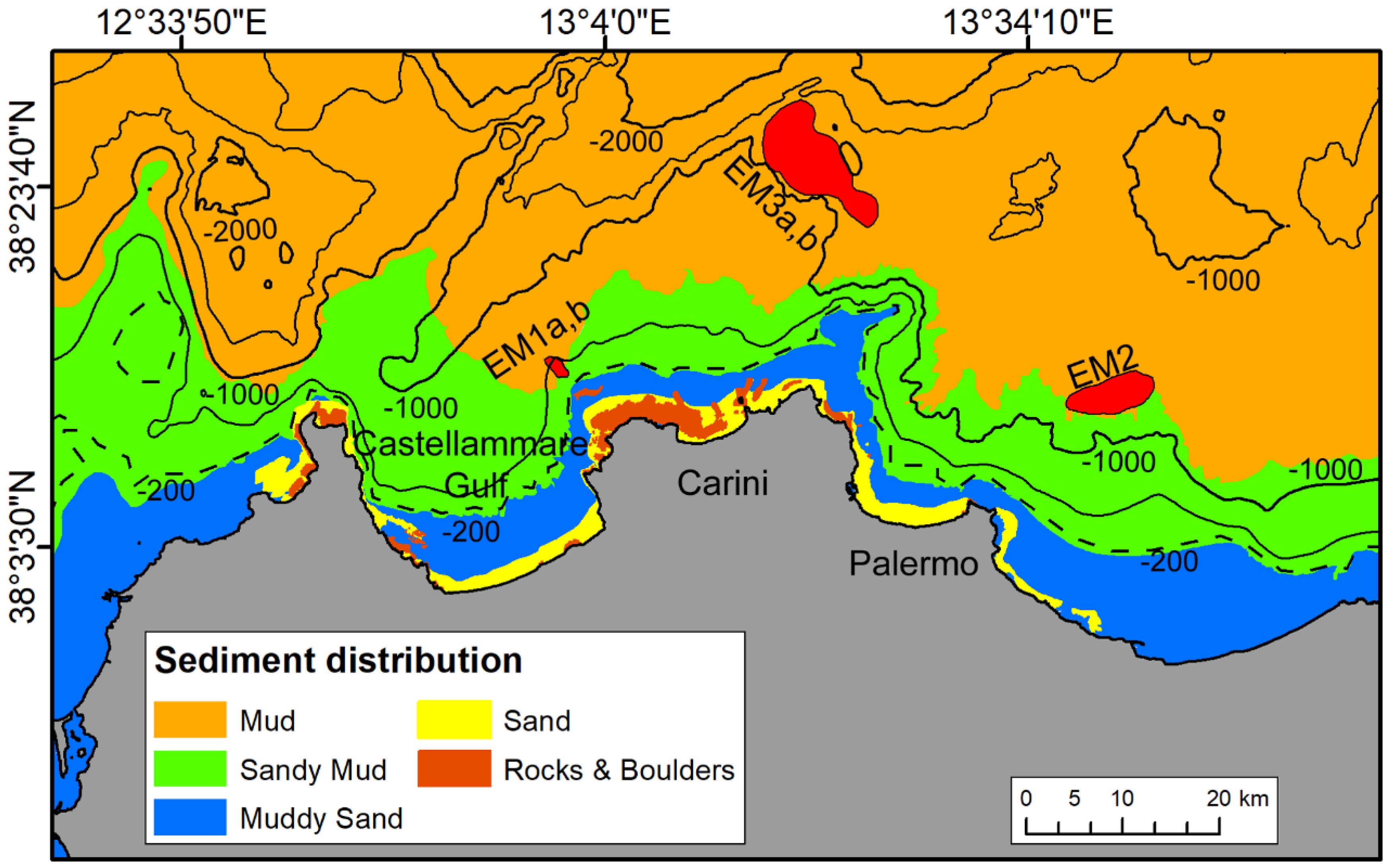
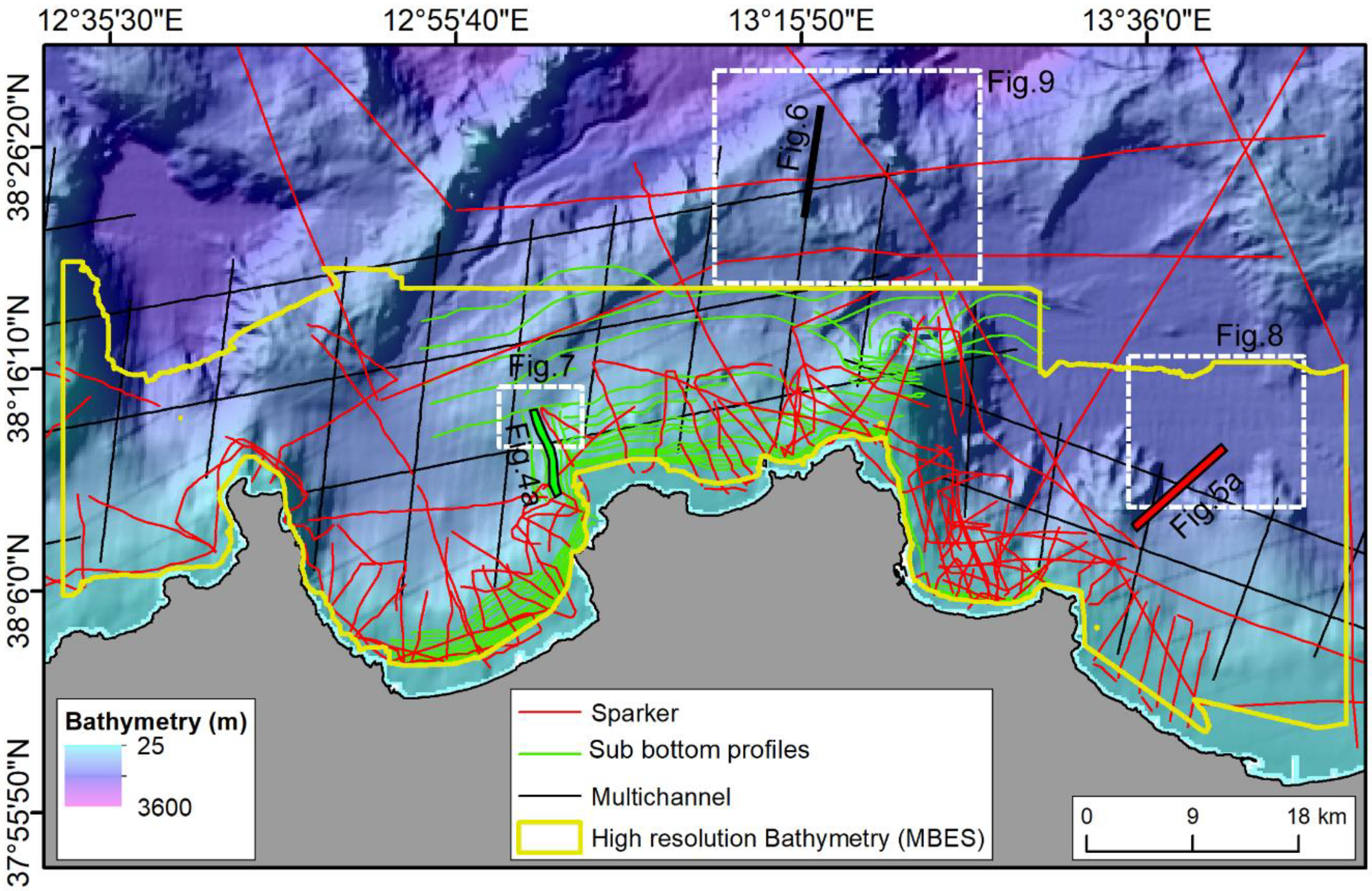
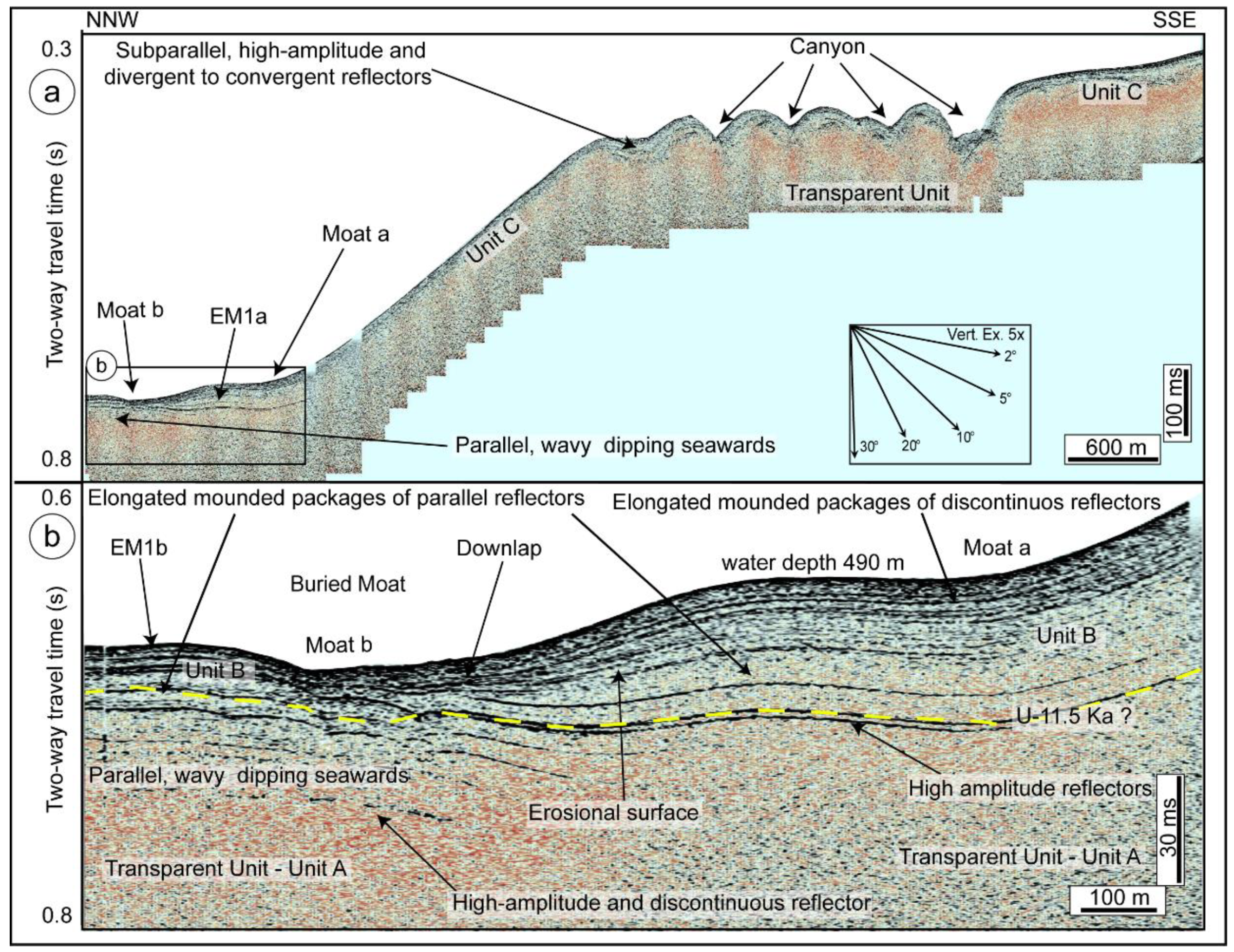
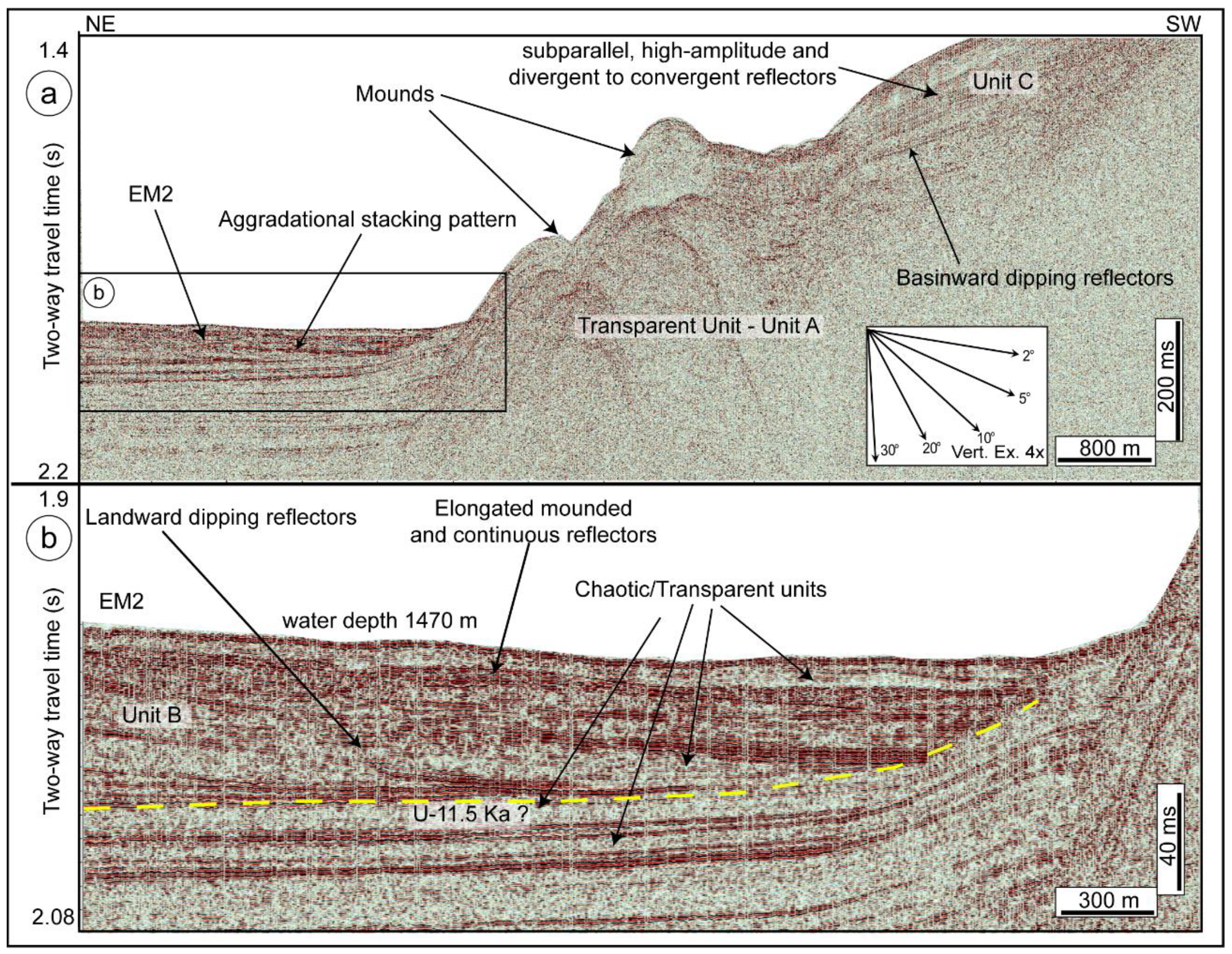
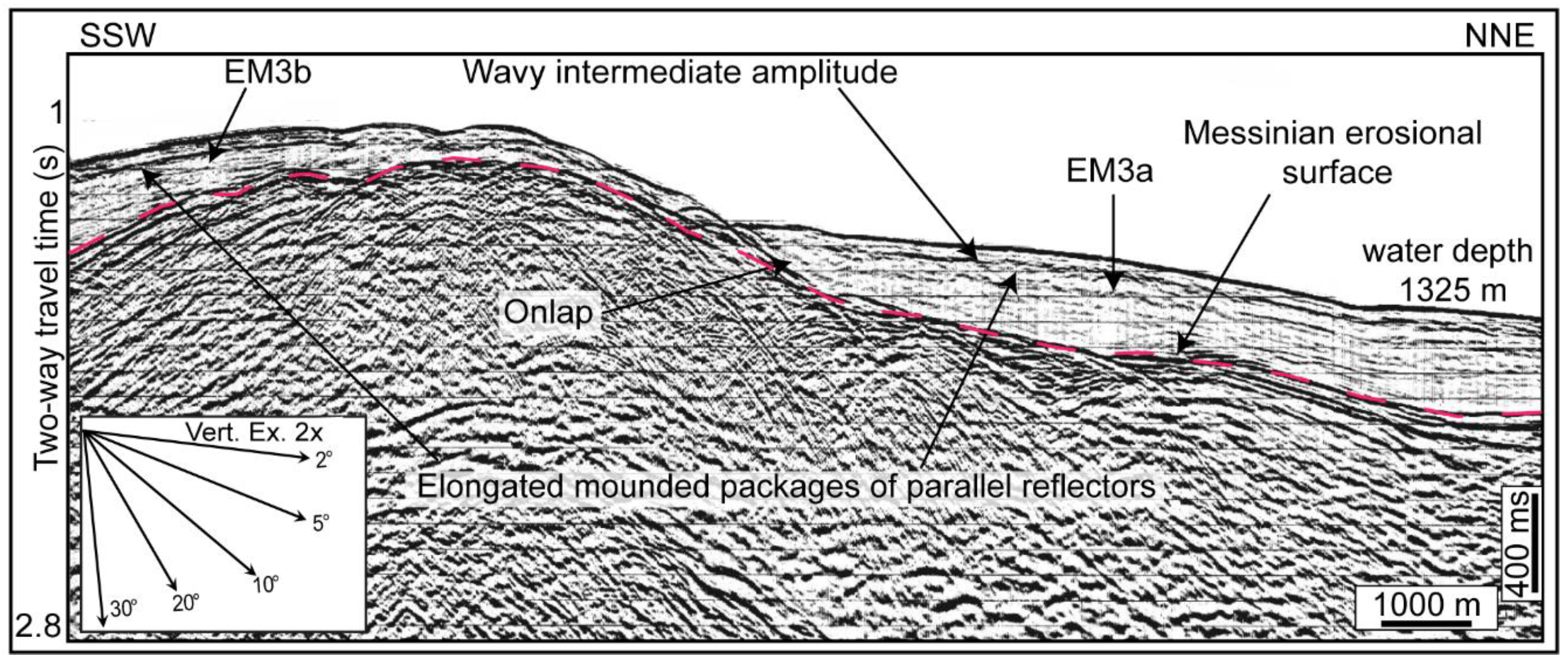


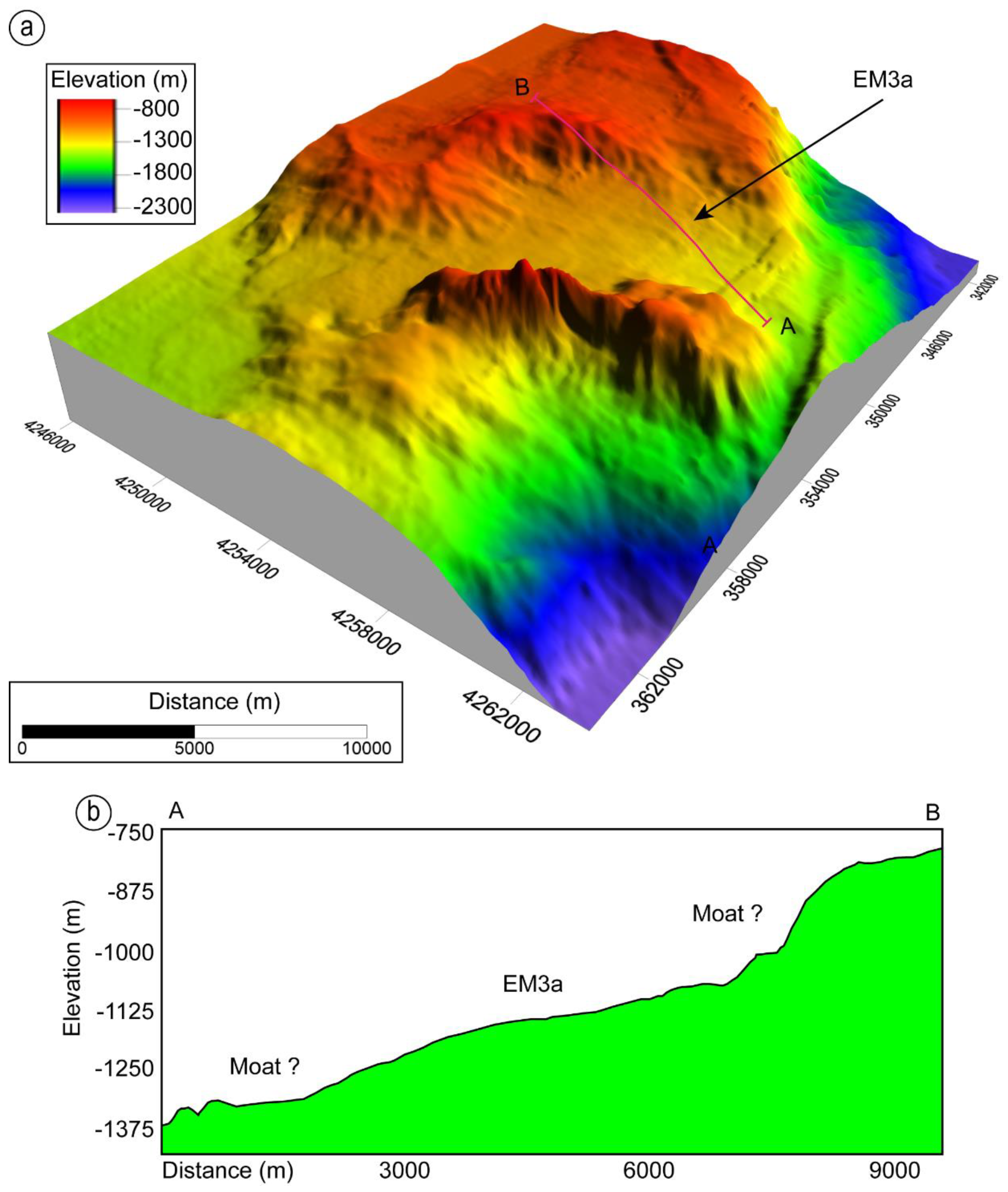
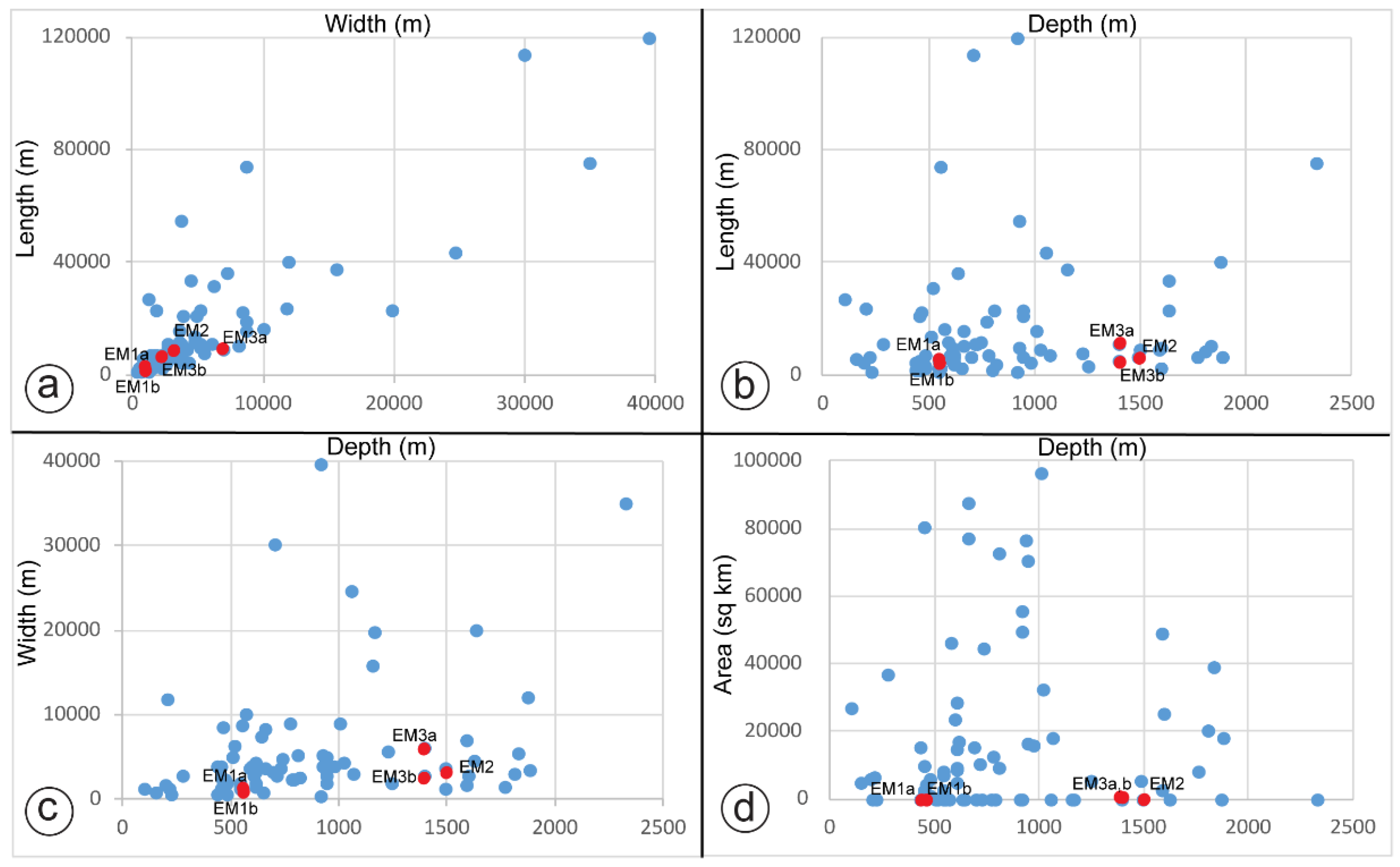

Publisher’s Note: MDPI stays neutral with regard to jurisdictional claims in published maps and institutional affiliations. |
© 2021 by the authors. Licensee MDPI, Basel, Switzerland. This article is an open access article distributed under the terms and conditions of the Creative Commons Attribution (CC BY) license (https://creativecommons.org/licenses/by/4.0/).
Share and Cite
Spatola, D.; Sulli, A.; Casalbore, D.; Chiocci, F.L. First Evidence of Contourite Drifts in the North-Western Sicilian Active Continental Margin (Southern Tyrrhenian Sea). J. Mar. Sci. Eng. 2021, 9, 1043. https://doi.org/10.3390/jmse9101043
Spatola D, Sulli A, Casalbore D, Chiocci FL. First Evidence of Contourite Drifts in the North-Western Sicilian Active Continental Margin (Southern Tyrrhenian Sea). Journal of Marine Science and Engineering. 2021; 9(10):1043. https://doi.org/10.3390/jmse9101043
Chicago/Turabian StyleSpatola, Daniele, Attilio Sulli, Daniele Casalbore, and Francesco Latino Chiocci. 2021. "First Evidence of Contourite Drifts in the North-Western Sicilian Active Continental Margin (Southern Tyrrhenian Sea)" Journal of Marine Science and Engineering 9, no. 10: 1043. https://doi.org/10.3390/jmse9101043
APA StyleSpatola, D., Sulli, A., Casalbore, D., & Chiocci, F. L. (2021). First Evidence of Contourite Drifts in the North-Western Sicilian Active Continental Margin (Southern Tyrrhenian Sea). Journal of Marine Science and Engineering, 9(10), 1043. https://doi.org/10.3390/jmse9101043






